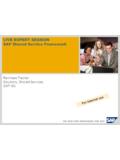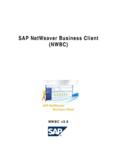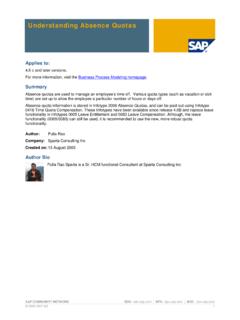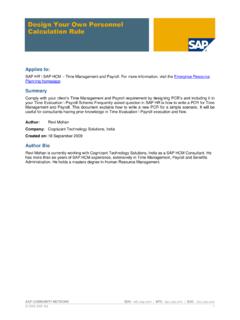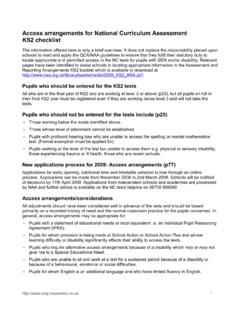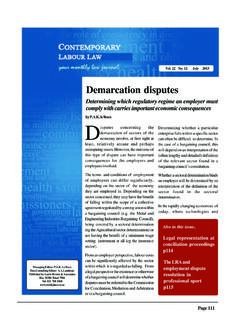Transcription of Real Time Information User Guide - Nicx Limited Winchester
1 real time Information User Guide 2 | Page Table of Contents real time Information .. 5 RTI reporting - Interim Solution .. 5 RTI reporting in detail .. 6 New Business Practices to support the FPS submissions .. 8 Employer Payment 8 Employer Alignment Submissions .. 8 Activating the 9 1. Feature: GBCHG .. 9 2. Rule G048 .. 9 Features .. 10 GBIT9 .. 10 GBPEN .. 10 GP46E .. 11 GBIEI .. 11 Processing Class .. 13 48 .. 13 49 .. 13 Wagetypes .. 14 A080 .. 14 A081 .. 14 A082 .. 14 LOP .. 14 NHWK .. 14 PYNI .. 14 UNPA .. 14 171 - Net Additions .. 15 A71 - Net Additions .. 15 Z71 - Net Additions .. 15 172 Ben Payroll .. 15 A72 - Net Additions .. 15 Z72 - Net Additions .. 15 3 | Page 175 RTI NI only .. 15 A75 - Net Additions .. 15 Z76 - Net Additions .. 15 176 - EE Net pension deduction.
2 16 A76 - Net Additions .. 16 Z76 - Net Additions .. 16 178 Pre tax deductions .. 16 A78 - Net Additions .. 16 Z78 - Net Additions .. 16 PCRs .. 17 G048 .. 17 GG41 .. 17 Payroll Function: GBRTI .. 18 GBRTI (parameter 1) .. 18 GBRTI (parameter 2) .. 20 Deriving fields for RTI .. 24 40A-Irr Pymt Ind .. 24 49-NI aggregation .. 25 59-RTI Net Pay .. 25 61- This Period Pension Contributions Pre-tax pensions .. 25 RTI indicator .. 25 XML ID/Global ID .. 25 Deriving fields for Multiple 26 Non Primary .. 26 Primary .. 26 BADI in payroll function GBRTI (parameter 2) .. 27 Tax Calculation after RTI .. 27 The new IT0065 .. 28 The new IT0088 .. 30 Pre DME Program .. 32 Full Payment Submission .. 34 Communication Channels .. 36 4 | Page ZIP .. 36 Employer Payment Submission .. 37 Communication Channels.
3 38 ZIP .. 39 Works Number .. 39 P45 Report .. 40 Display previous submission data .. 41 Earlier Year Update .. 41 Reconciliation report .. 43 Transaction Codes for various reports .. 44 5 | Page real time Information real time Information (RTI) is a government initiative designed to improve the operation of Pay As You Earn (PAYE). It will make the PAYE system easier for employers and HM Revenue & Customs (HMRC) to operate, and employees will receive Information more quickly. It will also help support the introduction of Universal Credits which is another government initiative that is due to go-live in October 2013. The fundamentals of PAYE are unchanged, for example, use of codes, employers deducting tax and National Insurance. What RTI does change is how and when employers and pension providers report Information to HMRC.
4 All employers will be required to submit their RTI data to HMRC every time they make a payment to an employee/pensioner. So, employers who operate a weekly payroll will be required to submit the data on a weekly basis at the same time as they their send the file to BACS to credit the employees bank accounts. HMRC s strategic solution is to enhance the BACS payment process which is used by almost all employers to incorporate the employee legislative data into one file and use BACS as the communication channel but as an interim measure, current communication channels can be used and at SAP, we have decided to continue to use Internet Submissions as our channel of communication. RTI reporting - Interim Solution The Interim solution for RTI reporting is: 1.
5 Employers send file to BACS via their BASS (BACS Accredited Software Supplier) containing the payment Information and a generated RTI reference for each employee (see Full Payment Submission for the detail on the RTI reference) 2. An RTI file containing a hash per employee will be sent to HMRC via the government gateway (see Full Payment Submission for the detail on generating the hash) 3. The Gov Gate will send a success message that the file has been validated and accepted and update the HMRC systems. 4. BACS will credit the employees bank accounts and create a hash with the same data as the employer and send this to HMRC 5. HMRC will use the hash for matching the payment and RTI data per employee. 6 | Page RTI reporting in detail All employers will be required to send their real time Information data to HMRC every time they make a payment to an employee/pensioner in a Full Payment submission (FPS) but prior to the first RTI FPS submission, it will be necessary for all employers to synchronize their employee data with HMRC in a data alignment Submission (EAS).
6 The National Insurance Number (NINo) will become the primary identifier for all employees and where one does not exist, it will be possible to request a missing NINo or validate an existing NINo by submitting the NVR file. If an employer needs to make amendments to the employer data, for example he needs to adjust the amount of Tax, NI compensation etc., he can then submit an Employer payment Submission (EPS). There will be 5 different types of submissions to be sent to HMRC File Type FPS Full Payment Submission The main RTI submission type giving a breakdown of the PAYE calculation for each employee/pensioner on each pay day EPS Employer Payment Submission A monthly opportunity for an employer to adjust the amount of Tax, NI etc.
7 Due, to take account of changes applied at an employer level (NI Compensation etc.) EAS Employer Alignment Submission A means of sending details of active employments to HMRC so that HMRC and Employer data can be aligned NVR NINO Verification Service An opportunity to validate NI No for employees EYU Earlier Year Update An opportunity to correct the values which were incorrectly submitted in the previous tax year 7 | Page NVR, FPS and EPS use the same schema but each has a different message class at the Government Gateway to identify the type of submission. Only one of these file types can be included in a single submission. They must be submitted via the Government Gateway. NVR is a request for NINO Information and must be sent to the Government Gateway.
8 A successful NINO Verification Request will generate a generic a success response through the Government Gateway. This will NOT include any NINO Information relating to the request. EAS has a separate xml schema with its own message class at the Gateway. The BACS file must also be amended to incorporate the generated RTI reference and included in field 7 of the standard 18 BACS file format. On receipt of the BACS file, Vocalink will also generate a hash of the same items of data as the employer and will forward the hash to HMRC who will then have all the Information they require to match the data for a single employee. Certain data items are only required to be reported for new starts. Address, Date of Employers still have to send P45 to Employee and that a new starts will still bring a P45.
9 Also all new starts have to be reported with a starter declaration based on the P46 statements even if they provide a P45. All new starts will be notified to HMRC with form type P46 and depending on the employee s circumstances, (example: Statement A - This is my first job since 6 April will attract the current emergency tax code on a cumulative basis.) unless the starter produces a document from his previous employer showing the tax code that was used in his previous employment. In these cases, the previous tax code should be reported to HMRC and used for calculating the tax liability. Similarly, providing the previous tax code had been operated on a cumulative basis, the previous earnings and tax should be taken in account when calculating the tax although it is not required to be reported to HMRC on the RTI file.
10 8 | Page New Business Practices to support the FPS submissions There will be a requirement for all employers to review their business practices and in preparation of HMRC s strategic solution of sending RTI data in the same file as the BACS data, it might be prudent to consider this requirement when introducing RTI. 1. All payments where possible should be made using BACS as this will enable HMRC to reconcile the payment made to the employee with the reported values from the FPS report. 2. Where an employee does not provide bank details, some employers hold any payments due as employers are not supposed to hold on to monies due to employees, Where an employee has no infotype 0009 maintained, the record will be rejected in the payroll 3.

